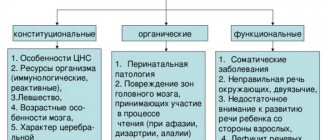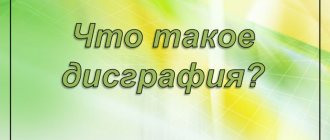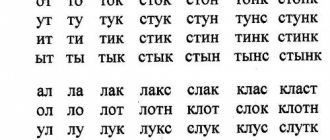Have you ever encountered the following situation? We check the child’s writing notebooks and notice a huge number of errors. This is not necessarily a sign of laziness or illiteracy, because there is such a disorder of written speech and mental functions of the brain as dysgraphia in children
The concept of dysgraphia as a disorder of written speech
What is dysgraphia?
In one of the previous articles we discussed the topic of dyslexia. It was also said there that these are similar developmental disorders, and they almost always overlap, but do not always accompany each other. In Russia, while receiving primary education, more than thirty percent of primary school students have this deviation, so the disorder is common and it is very important to learn to recognize it, understand its causes and know ways to overcome such a problem.
Dysgraphia is a written language disorder in which obvious errors are made when writing and which requires speech therapy correction.
Like dyslexia, dysgraphia has several forms, each of which has its own characteristics, and, more precisely, its own examples of errors made by children. The following forms of dysgraphia can be distinguished:
- Acoustic
- Articulatory-acoustic
- Optical
- Ungrammatical
- Dysgraphia associated with non-perception of language analysis and synthesis
How does phonemic hearing develop?
Phonemic hearing is formed during the child’s communication with family and surrounding people. Therefore, experts advise talking to the baby, reading books and poems to him from the moment he is born. The most significant progress in the development of phonemic hearing is observed between the ages of six months and two years. However, the parts of the cerebral cortex responsible for its functioning are finally formed by the age of 5-7 years.
- From birth to 1 year. The child begins to respond to loud sounds three weeks after birth, and to quiet sounds after 2 months. At 3 months, babies are good at identifying their sources, turning their gaze in their direction. At 4 months the child can imitate sounds, and at 5 months he understands his name. At one year of age, the baby is able to distinguish frequently used words.
- From 1 year to 2 years. At this age, there is an active development of phonemic hearing. The child manages to distinguish sounds in his native language. By the age of two, children can identify erroneous phonemes by ear. The child is able to tell which word was pronounced correctly.
- From 2 to 4 years. By the age of three, the baby stops confusing similar sounds. The correct syllabic structure of the word is also formed. Although there may be problems when pronouncing sounds, for example, children say “na-ni-na” together with “car”.
- From 4 to 6 years. At the age of five, the baby learns to determine the number and sequence of sounds in a word. This is an important stage on which the development of reading and writing skills depends. A six-year-old child can distinguish between the tempo and volume of speech.
Of course, every child has their own developmental standards. But strong deviations may indicate phonetic-phonemic underdevelopment.
Symptoms of dysgraphia in a child
Phonemic perception
This form of written language impairment involves the presence of poor phonemic awareness. When practicing writing, one replaces some with other letters that denote similar sounds. For example, replacing paired consonants “b” / “p”, “d” / “t”, “g” / “k”, consonant vowels “o” / “u”, “e” / “yu” or complex sounds and their components “a” / “i”, “ts” / “s”, “ts” / “t”, “h” / “shch” and so on.
In case of acoustic dysgraphia there are no problems with hearing and oral speech
.
Errors in pronunciation of sounds
In this case, the symptoms described above remain, only errors in the pronunciation of sounds are added to acoustic dysgraphia. In fact, this is a combination of acoustic and phonemic dyslexia. The child reads and writes words incorrectly and confuses similar sounds.
Articulatory-acoustic and articulatory disorders occur in children with phonetic-phonemic speech disorders.
Agrammatic speech disorder
There are difficulties in pronouncing text that has been read and is due to unformed speech. The student writes and pronounces without fully realizing syllabic perception and the meaning of the formation of words. It is difficult for him to find synonyms or antonyms, to describe something correctly, or to form the necessary form of a word (for example, a diminutive or plural). There may also be difficulties in constructing complex sentences (for example, he omits one or another member of a grammatical sentence or violates the rules of their sequence). Agrammatic dysgraphia is often found in bilingual families.
Optical dysgraphia of writing
In this case, the child's brain confuses visually similar letters. He can add or remove elements of letters, as a result of the formation of words, both existing and non-existent signs are obtained. For example, you can confuse “X” and “F”, “A” and “L”, and from the letter “E” you can make “S” in reverse. Also, sometimes with optical dysgraphia, letters are mirrored.
Underdevelopment of language analysis and synthesis
Despite the complex name, this type of dysgraphia is quite simple to identify. A student suffering from it, in the process of writing, misses letters or syllables, changes their places, duplicates or even adds something that is not there. Also, a student may confuse in written work where a space is needed and where not, or not complete words. There are also difficulties in defining the boundaries of the proposal.
Inattention or a real problem?
Before you panic, you need to accurately determine whether this is due to inattention caused by the child’s painful condition, overwork, or a real problem. To do this, you need to observe the child as he reads and writes. If, when reading, he sometimes forgets letters, and when writing, he confuses similar signs, because he has just begun to study these letters or remembers them after a summer vacation, there is no reason to worry.
Another case is if a child cannot read a word because he constantly forgets the letters, and also does not remember how and in which direction to write them. If such errors are persistent, then this may be signs of dyslexia (problems with reading) or dysgraphia (difficulty in writing).
Dyslexia is a common problem, the main characteristic of which is an incomplete reading disorder - the child reads, but constantly makes the same mistakes. He can skip letters, syllables or entire words, add new characters to words, and confuse them in places. Often children simply do not distinguish between certain sounds, cannot reproduce them and use them not only in oral speech, but also in writing or reading. Very often, a child has not only dyslexia, but also dysgraphia.
Dysgraphia is a persistent impairment in children's ability to write. If a child confuses and swaps syllables and letters when writing, this may cause illiteracy in the future. Very often, such children have illegible handwriting due to constant doubts about the spelling of specific letters, syllables or words. They may not write capital letters or use punctuation at the end of sentences.
Children with dysgraphia in high school try to write in small phrases, using a minimum number of words, but still make mistakes. Classes in which they need to write become painful for them, so they often skip them. They begin to feel a sense of inferiority, which further leads to the development of complexes and aggression. In advanced cases, over time, teenagers become outcasts in the team.
As you can see, confusing letters when reading and writing can lead to quite serious consequences. Therefore, it is extremely important to notice the problem in time and take action. The sooner parents turn to a speech therapist for help, the faster and easier the correction will be for the child. He will catch up with his peers and will be able to master the school curriculum normally.
Causes of impairment of writing and speech reproduction of information
Why does a child write poorly or why does a child read poorly? Not surprisingly, the causes of dysgraphia are similar to the causes of dyslexia.
- Hereditary predisposition
- Diseases suffered during the perinatal period of development, as well as various complicating factors (bad habits of the mother, complicated toxicosis, asphyxia, short interval between the mother’s pregnancies, and so on)
- Internal functional reasons (long-term somatic diseases, etc.)
- External functional reasons (improper speech education)
- Lack of school readiness for writing
- Minimal brain dysfunction
- Impaired mental function
- Attention Deficit Hyperactivity Disorder
- General speech underdevelopment
- Impaired pronunciation of speech (dysarthria)
- Strokes, traumatic brain injuries, neurosurgery and brain tumors (possibly in adulthood)
Dysgraphia, like dyslexia, can lead to many problems. Among them are a drop in educational motivation, underdevelopment of speech, school failure, undeservedly poor performance, and so on. Therefore, it is very important to realize that it is not the child’s fault that he writes incorrectly, and this problem is not related to his schooling.
Responsibility for correcting the violation lies, of course, with specialists, but first of all, with parents!
As well as the process of development of their pet as a whole. All that is required of teachers is to recognize the violation in time and provide conditions in the classroom that promote the harmonious development of children, including the correction of dysgraphia.
But is it possible to confuse dysgraphia and other developmental disorders?
How not to do this?
What factors contribute to the appearance of childhood dysgraphia?
There are many reasons for the disease. Let's highlight the main ones:
- a preschool child is raised in a bilingual or multilingual family;
- from early childhood, the child experiences a constant lack of communication, against the backdrop of a lack of constant verbal contact;
- the development of children occurs against the background of constant incorrect speech of the people who surround them;
- adults have a habit of speaking to the baby, pronouncing most words unclearly;
- Parents make the mistake of trying to teach their child to read and write when he is not mentally and, most importantly, psychologically ready for this activity.
The disease often appears in children if they have experienced serious birth trauma, asphyxia, for example, during childbirth, or have suffered encephalitis.
Diagnosis of dysgraphia disorder by a speech therapist
Unfortunately, you will not be able to make a diagnosis and therefore contact a medical center. It is necessary to carry out a process of speech analysis of written grammar. You will have to undergo diagnostics and examination by a number of specialists, among them: a neurologist, an ophthalmologist, an otolaryngologist, a speech therapist and a psychoneurologist (the latter, in fact, make the final diagnosis). Each of the doctors checks whether the subject has any health problems that could lead to a disruption in the writing process, in addition to dysgraphia. Let's assume that the diagnosis has already been made. The main question that faces us now is how to deal with dysgraphia in a child?
How to teach a child to write without mistakes?
Let's look at not the most obvious, but useful ways to improve a child's literacy.
- Development of fine motor skills of the hands . Modeling from clay and plasticine, cutting out small figures from paper helps. Fingers become more agile, handwriting improves. This affects literacy: the child remembers the outlines of letters, they cease to be a continuous stream of symbols. The student can more easily recognize the endings of words.
- Working on calligraphy . Many are convinced that beautiful handwriting does not play a special role, but teachers claim that clear, clean writing guarantees easy assimilation of theoretical material and a high degree of literacy.
- Watch your body position while writing . In the Soviet school, a lot of attention was paid to posture, and this has not lost its relevance. The back should be straight, the elbows should be placed on the surface of the desk so that they do not hang from it. There is no need to rest your stomach on the edge of the table. It is better to place the child’s legs straight, relaxed, without throwing them over each other. The notebook can be tilted slightly. Also buy a comfortable handle that won't slip in your hands.
- Reading aloud . Little by little, the child will begin to see visual images of words that are pronounced during role-playing. This will help you write more competently.
There are methods developed by teachers that are regularly used by teachers in primary schools. Here are some of them.
- Method of P. S. Totsky . The system is called “Spelling without rules.” It is based on the slow pronunciation of words, thanks to which motor memory (lip and tongue movements) develops.
- Visual dictations by I. T. Fedorenko . The student is allowed to read the sentence to himself, then he writes down what he saw. Training continues until the set of cards is completely mastered by the child.
- N. Sycheva “Writing without errors” . The technique offers brief mechanisms for searching for spelling in words, test tasks, and additional materials.
If you do not want to understand pedagogical methods, you can use regular exercises in a playful way.
- Warm up before starting class . We remember the outlines of the letters: we draw with our fingers on paper or in the air and try to guess.
- Making educational posters . Write down with your child the basic rules and words in which he makes mistakes. The child’s participation will make the poster more convenient and understandable.
- We write a letter to a friend or compose a fairy tale. The main condition is that in each sentence you need to use one of the rules that cause difficulties.
- Bring documents from work, demonstrate how important it is to be able to write correctly : the quality of work, the respect of colleagues for well-completed tasks, and even the amount of money depend on this. The child needs to understand why he is learning the rules and how they are useful in real life.
Work on dysgraphia correction with a speech therapist
Any doctor will tell you that self-medication is unacceptable, and this is true.
Basically, a speech therapist works with dysgraphia, but a neuropsychologist, a psychotherapist, and an educational psychologist can also work.
You should prepare for the fact that the process of eliminating speech and writing disorders will not be quick. The correction program is built depending on the causes, type of violation and age characteristics. The older he is, the more difficult it is to carry out the correction.
Is reading not a panacea?
Vladimir mother Anna Forsova has already taught her two daughters at school, and is now helping her son defeat “the great and mighty.” Anna's son entered sixth grade. And if everything is good with mathematics, then the student’s Russian language is not very good. The woman complains that there were no problems with her daughters, but her son can make two or three mistakes in one word:
“And again a year of torment with unstressed vowels, unpronounceable consonants and dictionary words began for us. The teacher tells us: learn the rules, read books. But it doesn’t work for us, nothing helps overcome our illiteracy.
Photo: nanya.ru
Cases when medication or physiotherapeutic treatment is necessary
If there is an organic cause of dysgraphia, then its treatment will be prescribed (medication, physiotherapy, and so on). Similar methods of treatment are prescribed for aggravated disorganization of written speech, leading to the impossibility of writing (Agraphia). Various exercises will be carried out with a speech therapist. You can apply some of them yourself and work with your child at home, in this way you will not only help with the correction, but also get closer to your baby.
Causes
Doctors, trying to help the expectant mother give birth faster, make the mistake of stimulating labor. With this method of birth, the temporal areas of the baby’s head, which are responsible for the speech zones, suffer. The consequences can be very different: for example, violations of oral and written speech.
Reading impairment is called dyslexia, writing impairment is called dysgraphia. Both disorders can be observed in the same child, and no signs of mental retardation are found in him. Dyslexia can be passed on from parents.
Exercises to correct dysgraphia at home
Is it possible to correct and how to correct dysgraphia at home? Yes, after consultation with a speech therapist and his analysis of the situation, the main burden falls on doing the exercises at home. Below are exercises for correction. You can apply them and practice them yourself. This way you will not only help the correction, but also get closer to your baby.
"Labyrinth"
You need to go through the labyrinth by drawing a continuous line on a piece of paper without lifting your hand or turning the labyrinth.
Graphic dictations
These are tasks in which you need to draw something on a checkered sheet of paper based on prompts. There are graphic dictations in which a letter or number must be obtained.
Construction of signs from elements
You can make letters and numbers from different objects: counting sticks, pencils, cereals, plasticine, and so on. You can draw drawings on paper in the form of signs. From already composed symbols, you can recompose them. Take them apart and put them back together.
Schulte tables
Schulte tables, the Munstenberg technique and other psychological methods for developing attention related to numbers. According to psychologists, this is especially effective when the child is between 10 and 11 years old.
Crosswords
Scanwords, crosswords, English crosswords, Sudoku and other puzzles.
Recognizing incomplete notations
Play recognizing letters and numbers that are not fully drawn. Let the child add the part of the sign that is missing. Some designs can be continued into several different symbols. For example, the letter “B” and the number “5” have a common part.
Finding missing letters in a word
Write a word and deliberately leave out a letter or even a syllable. Let the student analyze the word, find gaps, highlight the syllable, correct the mistake and name the correct spelling.
Memorizing poems
This is also a kind of exercise that develops memory and speech. In our case, poetry will help us gain a sense of rhythm in speech.
Play with words
Make anagrams: rearrange letters and syllables in words so that they form new words or phrases. You can also take some medium or large word and try to make words from the letters in it. There are a lot of similar techniques.
Development of fine motor skills
It seems that everyone around is already repeating this: the development of speech is associated with fine motor skills. Make the most of this opportunity: let the child’s psyche take a break from the Russian language, and let him take up modeling, beads, construction sets, origami and other interesting activities. Turn on your imagination - and you will succeed. In addition, it will be extremely interesting for both you and the child!
Psychological comfort when writing
You must provide your pupil, first of all, with psychological comfort, because without it the problem will either not be solved, or will be solved, but with consequences of a different nature. Fear of the teacher, hatred of writing and lessons, shame in front of classmates and more.
- Talk to teachers. Explain the seriousness of the situation and ask them to behave competently. Let them not focus the attention of other children on the problem and be patient. The teacher's duty is to treat his student with understanding. This means helping, stopping the ridicule of others and not scolding for mistakes. A teacher who does not understand this can not only interfere with the correction of dysgraphia, but also lead the student to nervous overstrain. Just imagine the situation. You are a small child of 8 years old who cannot do what all girls and boys do with ease. At the same time, an adult, a teacher with whom you often have contact, scolds you for writing mistakes, and meanwhile your peers ridicule them. And this continues for quite a long time, day after day. I think it is obvious that the little person will have neither educational motivation, nor trust in others, nor healthy self-esteem.
- Charge your child only with positive energy. Praise your child for successes more often and do not talk about bad things. It is very important that he believes in himself and does not give up, that is, does not stop doing writing exercises just because he is tired or something does not work out. At the same time, do not force him to overwork: everything should be in moderation. Otherwise, breakdowns cannot be avoided. Remember that parents are the most important thing your son or daughter has. They are his best friends and the closest people in his life. Who, if not you, will support your child in achieving success?
Article:
As they begin school, some children suddenly develop difficulties with reading and writing.
The diagnosis of dyslexia causes a feeling of confusion and fear in parents. Is their baby seriously ill? Is this treatable? How to help a child with dyslexia? “Dysgraphics” and “dyslexics” are teased by teachers, scolded by parents at home, and, in addition, teased by peers.
There are many myths regarding the occurrence of dysgraphia and dyslexia.
One of them is that children with such disorders are allegedly mentally retarded. Another myth is that these children were taught using newfangled methods that were “originally and fundamentally wrong.”
To figure out where, after all, the truth is, let’s turn to child psychologists and speech therapists, as well as to the data of their research.
Dyslexia and dysgraphia: what is it?
In psychoneurology, dyslexia is a reading disorder, and dysgraphia is a writing disorder.
Children with dyslexia make mistakes when reading: they skip sounds, add unnecessary ones, distort the sound of words, their reading speed is low, children change letters in places, sometimes miss the initial syllables of words... The ability to clearly perceive certain sounds by ear and use them in their own speech often suffers. , when reading and writing. In this case, the ability to distinguish similar sounds is impaired: “B–P”, “D–T”, “K–G”, “S–Z”, “Zh–Sh”. Therefore, such children are very reluctant to complete tasks in the Russian language: retelling, reading, presentation - all these types of work are not given to them.
With dysgraphia, children have difficulty mastering writing: their dictations and the exercises they complete contain many grammatical errors. They don't use capital letters, punctuation, and have terrible handwriting. In middle and high school, children try to use short phrases with a limited set of words when writing, but when writing these words they make gross mistakes.
Often children refuse to attend Russian language classes or complete written assignments. They develop a sense of their own inferiority, depression, and are isolated in the group. Adults with a similar defect are unable to compose a greeting card or a short letter; they try to find a job where they do not have to write anything.
In children with dysgraphia, individual letters are incorrectly oriented in space. They confuse letters that are similar in style: “Z” and “E”, “P” and “b” (soft sign). They may not pay attention to the extra stick in the letter “Ш” or the “hook” in the letter “Ш”. Such children write slowly and unevenly; if they are not in the mood, not in the mood, then the handwriting is completely upset.
In general, it is not difficult to determine the presence of writing and reading disorders.
There are typical mistakes, the repetition of which over and over again when reading or writing should alert you:
1. Mixing letters when reading and writing by optical similarity: b – d; p – t; E – W; a – o; d – y, etc.
2. Errors associated with poor pronunciation. The absence of certain sounds or the replacement of some sounds with others in oral speech is correspondingly reflected in writing. The child writes the same thing he says: sapka (hat).
3. Mixing of phonemes based on acoustic-articulatory similarity, which occurs when phonemic perception is impaired. With this form of dysgraphia, it is especially difficult for children to write from dictation. The vowels o - u, e - yu are mixed; consonants r – l, y – l; paired voiced and voiceless consonants, whistling and hissing, the sounds ts, ch, shch are mixed both with each other and with other phonemes. For example: tublo (hollow), lebit (loves).
4. We are often happy when a child reads fluently in preschool age, and this, with an insufficiently formed phonetic-phonemic side, can lead to errors in writing: missing letters and syllables, underwriting words.
5. Frequent in dysgraphia are errors of perseveration (stuckness): “Behind the zoom, my mother grew” (Raspberries grew behind the house), anticipation (anticipation, anticipation): “Dod nebom blue sky” (Under the blue sky).
6. A large percentage of errors are due to the child’s inability to convey the softness of consonants in writing: salt (solit), vezet (lucky).
7. Continuous writing of prepositions, separate writing of prefixes is also one of the manifestations of dysgraphia.
All errors that can be attributed to dysgraphia and dyslexia are specific, typical and persistent. If your child makes similar mistakes, but they are isolated, then the reasons must be looked for elsewhere. Errors made due to ignorance of grammatical rules are not dysgraphic.
Here are some examples of texts for dysgraphia: 2-3 grades)
In the purer forest the siskins sing. The sun is shining, the linden tree is shining. The bush rustles, the gray bunny trembles. The bird cherry trees have bloomed. Larisa goes to get dressed. Zhurka was a shabby fatty. Delicate flowers swayed in the wind. Bevachka brushes her cloak. The boy is sitting in bed. The flowers are melting in a vase.
Why do reading and writing disorders occur?
The process of developing reading and writing is very complex. It involves four analyzers: speech motor, which helps to carry out articulation, that is, our pronunciation; speech-auditory, which helps to select the desired phoneme; visual, which selects the appropriate grapheme; motor, with the help of which the grapheme is translated into kineme (a set of certain movements necessary for recording). All these complex recodings are carried out in the parieto-occipital-temporal regions of the brain and are finally formed in the 10th–11th year of life. A letter begins with a motive, an incentive - this level is provided by the frontal lobes of the cerebral cortex.
Of great importance for mastering the processes of writing and reading is the degree of formation of all aspects of speech. Therefore, disturbances or delays in the development of phonemic perception, lexico-grammatical aspects, and sound pronunciation at different stages of development are one of the main causes of dysgraphia and dyslexia.
If a child has impaired speech hearing, then, of course, it is very difficult for him to learn to read and write. In fact, how can he read if he can’t hear the speech clearly? He is also unable to master writing, since he does not know what sound this or that letter represents. The task is further complicated by the fact that the child must correctly grasp a certain sound and imagine it as a sign (letter) in the fast stream of speech he perceives. Therefore, teaching literacy to a child with defective speech hearing is a complex pedagogical problem.
The risk group includes children who do not suffer from speech disorders, but have insufficiently clear articulation. They usually say about them: “He can barely move his tongue...” - they are called “mumbles.” A fuzzy command due to unclear articulation, and even when phonemic processes are underdeveloped, can also cause unclear responses, which entails errors in reading and writing.
Along with speech (phonemic) hearing, people have special vision for letters. It turns out that simply seeing the world around us (light, trees, people, various objects) is not enough to master writing. It is necessary to have vision for letters, allowing you to remember and reproduce their outlines.
This means that for full-fledged education, a child must have satisfactory intellectual development, speech hearing and special vision for letters. Otherwise, he will not be able to successfully master reading and writing.
The peculiarities of speech formation and, as a consequence, the appearance of dysgraphia and dyslexia are also influenced by more “deep” factors. For example, unequal development of the brain hemispheres.
Which area of the brain is responsible for writing and reading?
It turns out that the center of speech for most people is in the left hemisphere. The right hemisphere of the brain “manages” object symbols and visual images. Therefore, peoples whose writing is represented by hieroglyphs (for example, the Chinese) have a better developed right half of the brain. Writing and reading among Chinese residents, unlike Europeans, will suffer if there is a problem on the right side (for example, with a cerebral hemorrhage).
The anatomical features of the central nervous system explain the facts known to doctors that dysgraphics have good drawing abilities. Such a child has difficulty mastering writing, but receives praise from the art teacher. This is as it should be, because in this child the more “ancient”, automated area of the right hemisphere is not altered in any way. Problems with the Russian language do not prevent these children from “explaining themselves” with the help of drawings (as in ancient times - through images on rocks, birch bark, and clay products).
Speech therapists sometimes pay attention to the “mirror” nature of patients’ writing. In this case, the letters are turned in the other direction - as in the image in a mirror. Example: “C” and “W” open to the left; “Ch” and “P” are written in the other direction in the prominent part... Mirror writing is observed in various disorders, but the doctor with such a phenomenon looks for obvious or hidden left-handedness. He searches and often finds: mirror reversals of letters are a characteristic feature of left-handed people.
The hereditary factor also plays a role when the child is transmitted to the underformation of brain structures, their qualitative immaturity. In this case, as a result of difficulties in cortical control when mastering written speech, the child may experience approximately the same difficulties as parents at school. There is a genetic predisposition to the presence of this defect, as this disorder is observed in several members in individual families.
Reading disabilities often become apparent by 2nd grade. Sometimes dyslexia is compensated over time, but in some cases it remains at an older age.
The presence of congenital characteristics that influence the occurrence of dyslexia and dysgraphia explains the fact that often both types of disorders are observed in the same child. At the same time, such a child most often does not show signs of mental retardation. The child turns out to be at odds with the Russian language, although he copes well with mathematics and other subjects where, it would seem, more intelligence is required.
Another interesting observation by psychologists: dyslexia occurs 3-4 times more often in boys than in girls. About 5-8 percent of schoolchildren suffer from dyslexia. Sometimes, however, the cause of dysgraphia can be bilingualism in the family. Recently, due to major changes in the geography of society, when many are forced to leave their home to learn a second language, this reason is becoming increasingly relevant.
The cause of dyslexia and dysgraphia can also be a disorder in the systems that provide spatial and temporal education. Special literature provides data from the Claperad Institute, according to which the actions of the negative mother-child connection can be observed at the basis of dyslexia. Thus, a child who is force-fed, who becomes accustomed to resisting food, acquires the same manner in relation to intellectual food. This resistance, which he discovers when communicating with his mother, is then transferred to the teacher.
Even things that seem insignificant at first glance are important. For example, very often when reading, it is difficult for a child to follow the line, his eyes wander. Scientists, having conducted research, suggest that if in infancy a baby lies so that the TV screen falls into his field of vision, then the eye muscles get used to the chaotic movement. Therefore, in preschool age, exercises are useful to prepare the eye muscles for consistent tracking of the line.
The eternal question: what to do? What to do if a child has dyslexia or dysgraphia?
First of all: don't lose heart. Such children are quite capable of mastering reading and writing if they study persistently. Some will need years of study, others months. The essence of the lessons is training speech hearing and letter vision. It is best not only to contact a speech therapist, but also to work with the child yourself.
Speech therapy classes are usually conducted according to a certain system: various speech games, a split or magnetic alphabet for adding words, and highlighting the grammatical elements of words are used.
The child must learn how certain sounds are pronounced and which letter this sound corresponds to when writing. Usually, a speech therapist resorts to contrasts, “working out” how hard pronunciation differs from soft, deaf from voiced... Training is carried out by repeating words, dictation, selecting words based on given sounds, and analyzing the sound-letter composition of words. It is clear that they use visual material to help remember the shapes of letters: “O” resembles a hoop, “Zh” is a beetle, “S” is a crescent... You should not strive to increase the speed of reading and writing - the child must thoroughly “feel” individual sounds (letters) .
It is often also necessary to contact a psychoneurologist: he can help speech therapy sessions by recommending certain stimulating medications that improve memory and brain metabolism. The main thing is to remember that dyslexia and dysgraphia are conditions that require close cooperation between a doctor, speech therapist and parents to determine.
Currently, one of the most popular methods of combating dyslexia and dysgraphia is the Ronald Davis method.
There are several exercises that can help your child cope with dysgraphia:
1. Every day for 5 minutes (no more) the child crosses out the given letters in any text (except newspaper). You need to start with one vowel, then move on to consonants. The options can be very different. For example: cross out the letter a and circle the letter o. You can give paired consonants, as well as those whose pronunciation or distinction the child has problems with. For example: r – l, s – w, etc. After 2–2.5 months of such exercises (but provided that it is done daily and no more than 5 minutes), the quality of writing improves.
2. Write short dictations in pencil every day. A small text will not tire the child, and he will make fewer mistakes (which is very encouraging...) Write texts of 150 - 200 words, with checking. Do not correct errors in the text. Just mark the margins with a green, black or purple pen (never red!) Then give the notebook to your child to correct. The child has the opportunity not to cross out, but to erase his mistakes and write correctly. The goal was achieved: the errors were found by the child himself, corrected, and the notebook is in excellent condition.
3. Give your child exercises for reading slowly with pronounced articulation and copying text.
When working with your child, remember a few basic rules:
- Throughout special classes, the child needs a favorable regime. After numerous twos and threes, unpleasant conversations at home, he should feel at least a little success.
Scientists from the University of Washington in Seattle conducted research on the brain function of children with dyslexia. Neuropsychologists Virginia Berninger and Todd Richards led a team of researchers whose research showed that the brains of children with dyslexia work about five times harder than other children's brains when performing the same linguistic task. Do you think you're tired at the end of the school day? Imagine if your brain worked five times harder!
- Avoid testing your child's reading speed. It must be said that these checks have long been causing fair criticism from psychologists and defectologists. It’s also good if the teacher, understanding the stress the child experiences during this test, conducts it without emphasis, hidden. But it also happens that they create a complete exam situation, call the child alone, put a clock in front of him, and even check it not with his own teacher, but with the head teacher. Perhaps for a student without problems all this does not matter, but in our patients neurosis can develop. Therefore, if you really need to test your reading speed, do it as gently as possible.
- Remember that you cannot give exercises in which the text is written with errors (subject to correction).
- The “read and write more” approach will not bring success. Better less, but better quality. Do not read long texts or write long dictations with your child. In the first stages there should be more work with oral speech: exercises to develop phonemic perception, sound analysis of words. Numerous mistakes that a child with dysgraphia will inevitably make in a long dictation will only be recorded in his memory as a negative experience.
- Do not praise too much for small successes; it is better not to scold or be upset when the child does not succeed. It is very important not to show your child your emotional involvement: not to get angry, not irritated, and not to be overly happy.
A harmonious state of calm and confidence in success is better - it will be much more conducive to sustainable good results!
What is important to know about dysgraphia
- Dysgraphia is the most likely consequence of dyslexia. Since the child first reads and then writes, the difficulties that manifest themselves in reading are transferred to problems in writing. He first reads incorrectly and then writes incorrectly.
- Pathologies can also occur in adults. If corrective work is not carried out on time, then these speech and writing disorders can remain with the person for life. Accordingly, they will cause him more problems.
- Sometimes correction of dysgraphia is a long process. Parents need to be prepared for the fact that sometimes correction of dysgraphia, dyslexia and other related speech disorders may take more than one month or even one year, but several years. Willpower and patience will be required.
- If you have questions about how to treat dysgraphia, then dysgraphia is not a disease. And not even a mental disorder. This is only a disorder of speech development associated with the functioning of the brain. Therefore, it would be incorrect in this case to use the words “treatment”, “sick”, “disease” and others. However, it is also inappropriate to assume that this will “go away on its own.”
- Dysgraphic handwriting may be unclear. This is often associated with a violation of the motor and visual analyzers, so a child suffering from this may write illegibly and crookedly.
Risk groups for dysgraphia
There are certain risk groups for children who may develop dysgraphia.
Therefore, doctors must first diagnose and analyze the child’s sound pronunciation in the following cases:
- If he comes from a multilingual family;
- Previously had diseases of the hearing and speech apparatus;
- Left-handed or ambidextrous (a person for whom the left and right hands are equivalent);
- He started talking late;
- Left-handed, who was retrained to be right-handed;
- With disorders of phonetic perception;
- Has memory or attention problems;
- A student with a low level of school readiness;
- He writes as he speaks;
- Makes a small number of mistakes typical of dysgraphics.
Child's interest in writing
Games will help to interest the child. This is especially true if preschool children have dysgraphia.
If a child does not want to correct the violation and neglects written work, then exciting games will come to the rescue.
With your support, correction of dysgraphia will turn from backbreaking work into leisure.
Development of mental functions
The development of mental functions will help correct speech disorders at the initial stage. Activities for the development of fine and gross motor skills, attention, memory, thinking, intelligence, phonemic hearing, musical hearing, spatial perception, emotional-volitional qualities and other things - this is something that will be of great benefit in preventing difficulties with speech and the occurrence of distortions in recognizing the structure of the environment peace. In addition, developing a child’s psyche in itself is always useful and at any age (even when he is no longer a child).
Statistics on dysgraphia
The statistics on dysgraphia are astounding. According to research, approximately half of 2nd grade students have dysgraphia.
In a regular school this figure is almost forty percent.
This is due to the fact that about half of first-graders have phonetic-phonemic speech underdevelopment (FFS) or general speech underdevelopment (GSD), which prevents the child from becoming literate.
Compensation
Dysgraphia is not a death sentence
Of course, the violation is usually corrected. But it is also worth noting that some people highlight a peculiar advantage of dysgraphia. The fact is that the human brain has compensatory capabilities. This means that he can compensate for any gaps with something else. That is, if any ability of the brain is impaired, then another may be even too well developed. This fact and certain “statistics” may be the basis for the myth that dysgraphia is a “disease of geniuses.”
Indeed, we can observe that many geniuses suffered from this deviation.
Among them are Albert Einstein, Hans Christian Andersen, Thomas Alva Edison, Michael Faraday, Agatha Christie, Walt Disney, John F. Kennedy, Vladimir Mayakovsky, Steve Jobs and many others.
What to pay special attention to!!!
- If your child is left-handed.
- If he is a retrained right-hander.
- If your child attended a speech therapy group.
- If the family speaks two or more languages.
- If your child went to school too early (unreasonably earlier learning to read and write sometimes provokes the occurrence of dysgraphia and dyslexia). This happens in cases where the child has not yet reached psychological readiness for such training.
- If your child has problems with memory and attention.
Teacher - speech therapist of the State Budgetary Institution "PPC" Svetlana Vasilievna Zotova
How to teach a child to write dictations correctly at school
In order for your child to get high marks for dictations at school, you need to follow several simple but important principles.
- Painstaking work on mistakes is required. Review each teacher's comment with your child. Try to understand what you missed during class that caused the error.
- Make cards for particularly difficult cases, and return to them from time to time. You need to review the material you have covered a couple of times a week.
- Conduct home dictations so that your child gets used to this test format. This will reduce tension during school tests.
- Do not forget about the development of oral speech, which greatly affects literacy. Read your favorite books together, write down unclear words in your personal dictionary. Ask your child to retell the stories they read often.
- Let the child play the role of teacher. The parent sits down at the table and writes a text from dictation, making several mistakes. The child checks the work of his father or mother, comments, gives recommendations, and explains the material independently. This exercise relieves stress and fear of dictations.
The ability to write correctly and competently develops up to the age of 10, so do not be upset if children have difficulty remembering the rules in elementary school. Any problems can be solved with the help of parents, psychologists, speech therapists and the efforts of the child himself.
Russian language for students in grades 1-4
We develop thinking skills, prepare for Olympiads and improve results in the Russian language in an interactive format
find out more









